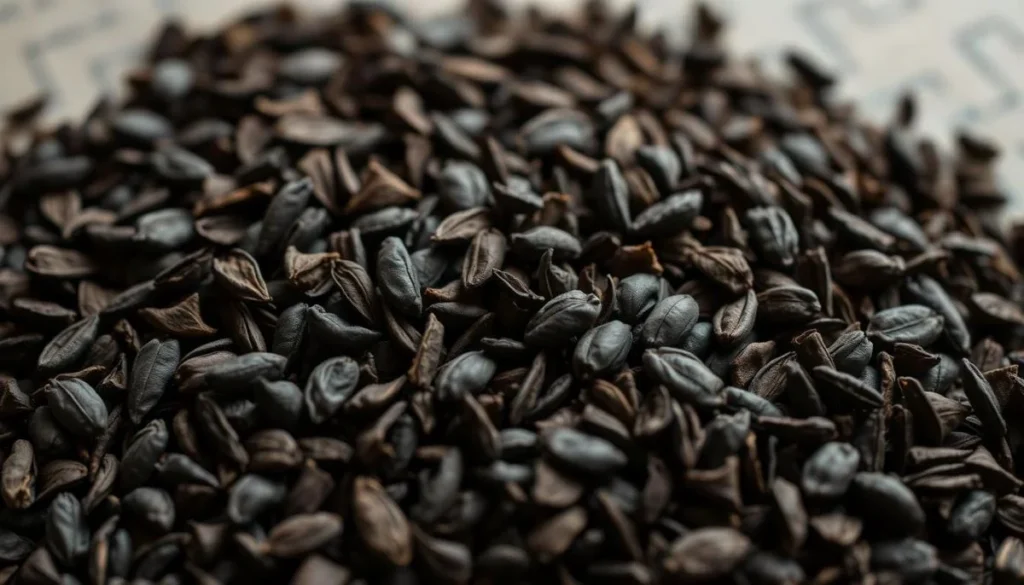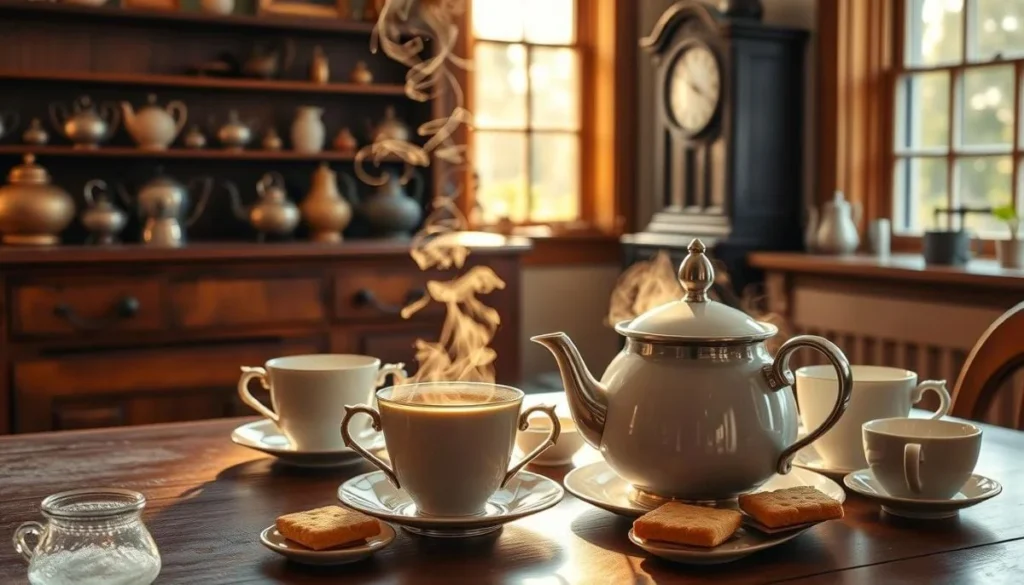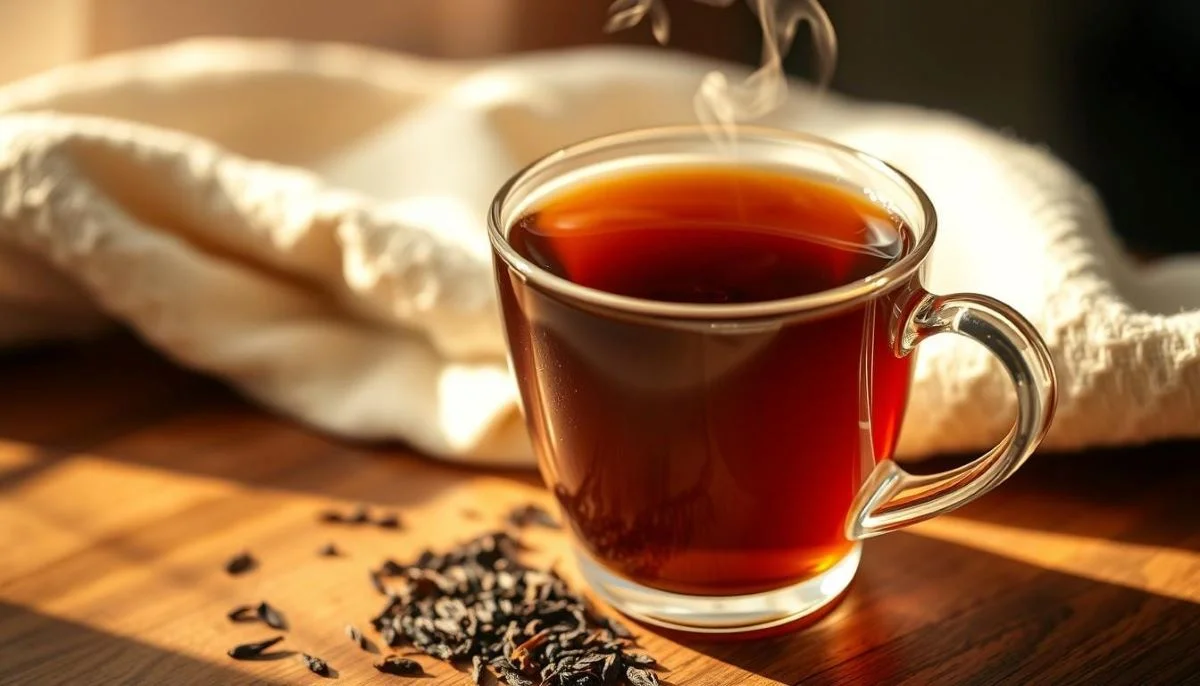Is English Breakfast Tea Black Tea? Explore the Facts
Every morning, millions of people enjoy a comforting cup of English tea. They wonder about its origins and unique taste. If you’ve ever wondered if English breakfast tea is really black tea, you’re not alone.
This beloved drink has a rich history and a complex flavor. It’s different from other teas. Black tea lovers know English breakfast tea is more than a morning drink. It’s a blend of black teas made to give strong flavor and energy.
The tea comes from the Camellia sinensis plant, the base of all true teas. What makes English breakfast tea special is its unique processing. Black teas are oxidized longer, making them darker and more flavorful.
From mellow Chinese teas to strong Assam ones, this blend offers a wide range of tastes. It can change how you start your day. Whether you love tea or just enjoy a good cup, learning about English breakfast tea will deepen your appreciation for it. Let’s explore what makes this black tea a favorite around the world.
Understanding English Breakfast Tea’s Composition
English Breakfast tea is a special mix of black teas. It combines flavors from different places, making a strong and tasty drink. This tea has won the hearts of many tea fans around the world.
The mix of English Breakfast tea is made with care. It includes leaves from several important areas:
- Assam tea from India
- Ceylon tea from Sri Lanka
- Keemun tea from China
- Kenyan black tea
Common Black Tea Varieties in the Blend
English Breakfast tea blends have a mix of strong black teas. Assam tea adds a malty, strong taste. Ceylon tea brings a bright and crisp flavor. Keemun tea from China adds a subtle smoky taste, making the blend more complex.
Key Characteristics of English Breakfast Tea
English Breakfast tea is known for its bold taste. It’s perfect for starting your day. The tea has a deep amber color, showing its rich flavor.
Traditional Tea Processing Methods
Black tea making involves careful steps. Leaves are withered, rolled, oxidized, and then fired. This process creates the tea’s deep color and strong taste. It makes sure every cup is as good as the last.
The Historical Origins of English Breakfast Tea
The tale of English breakfast tea starts in the mid-19th century. It’s a story that takes us across continents. This beloved tea wasn’t made in England, as many think.
Around 1843, the first “Breakfast Tea” mix was created in Scotland. It was made from Chinese black teas.
The tea quickly became popular in Victorian Great Britain. Richard Davies, a British tea merchant, helped make it famous. He moved to New York and named it “English Breakfast Tea.”
- First known Breakfast Tea blend created around 1843
- Original blend made from Chinese black teas
- Developed initially in Scotland, not England
- Rapidly gained popularity across social classes
In the 1840s, tea went from a luxury to a daily drink. The English breakfast blend was key. It was more than a drink; it was a cultural tradition.
The mix includes teas from Assam, Ceylon, and Kenya. This made a strong, full-bodied tea. It was perfect for British breakfasts and became a favorite.
“A cup of English Breakfast Tea is more than a drink – it’s a morning ritual that connects generations.”
Is English Breakfast Tea Black Tea: Everything You Need to Know
Explore the world of black tea and learn about English Breakfast tea. You’ll see why it’s a favorite among tea fans. It offers a special black tea experience.
The Camellia Sinensis Connection
English Breakfast tea comes from the amazing Camellia sinensis plant. This plant is the base for all true teas. It makes a strong and tasty drink loved by many.
The tea blend often includes leaves from places like India, China, Sri Lanka, and Tanzania.

Oxidation: The Color and Flavor Transformation
Black tea gets its unique taste from oxidation. Tea leaves are fully oxidized, changing color and flavor. This makes black tea dark brown to black.
- Complete oxidation develops robust flavors
- Leaves turn dark brown to black during processing
- Oxidation time impacts tea’s intensity and character
A Distinctive Flavor Profile
English Breakfast tea has a bold, hearty taste. It’s full-bodied with a hint of spice and a bit of astringency. Its strong flavor is perfect for the morning, even with milk and sugar.
Each cup tells a story of careful crafting and global tea traditions.
Nutritional Profile and Health Benefits
English breakfast tea is a favorite black tea that boosts your health. It’s full of antioxidants, making it more than just a morning drink.
This tea is very low in calories, with just zero per serving. Its real benefit is its high antioxidant content.
- Reduces risk of heart disease by 4%
- Potentially lowers stroke risk by 2%
- Contains beneficial polyphenols that support cellular health
- Provides 30-60 mg of caffeine per serving
Black teas like English breakfast offer many health benefits. Studies show they can:
- Cardiovascular protection: Lower blood pressure and cholesterol
- Cognitive function: Improve mental alertness and reduce cognitive decline risk
- Metabolic health: Help manage blood sugar levels
The tea’s mix of theaflavins and thearubigins may fight free radicals. This could lower cell damage and chronic disease risks. With its moderate caffeine, English breakfast tea gives energy without the jitters.
The Perfect Brewing Technique for English Breakfast Tea
Brewing the perfect cup of English breakfast tea needs precision and care. Whether you like loose leaf tea or tea bags, knowing the right technique makes a big difference. Learning how to prepare it well will bring out the rich flavors of this classic English tea.
Water Temperature and Steeping Precision
Getting the water temperature just right is key to getting the best taste from your tea. For English breakfast tea, heat the water to 100°C (212°F). Here are some brewing guidelines:
- Use one teaspoon of loose leaf tea per 8 oz cup
- Steep for 3-5 minutes depending on desired strength
- Avoid over-brewing to prevent bitterness
- Use fresh, filtered water for optimal flavor
Traditional Serving Methods
English breakfast tea has a rich cultural heritage that shapes its serving style. Traditional preparation includes specific steps:
- Warm your teapot or cup before brewing
- Use high-quality black tea blends
- Select porcelain or ceramic teaware for an authentic experience
Adding Milk and Sweeteners
Adding milk and sweeteners can make your tea your own. Here are some tips:
| Addition | Recommendation |
|---|---|
| Milk | Add after brewing for traditional English style |
| Sugar | One teaspoon recommended, adjust to taste |
| Honey | Natural alternative to sugar, use sparingly |
Pro tip: Clean your teaware regularly to keep the taste of your English breakfast tea pure. Tea oils left behind can change the taste of future brews.
English Breakfast Tea’s Global Popularity

English breakfast tea has become a favorite around the world. It started in Great Britain but now people everywhere love it. Its strong taste and easy brewing make it a hit.
Several things make english breakfast tea so popular:
- Its strong and full-bodied taste that appeals to many
- It fits into different cultural ways of drinking tea
- It has just the right amount of caffeine for mornings
- It’s simple to make
In countries all over, people have made their own special ways to enjoy it. In North America and Asia, fans love its complex flavors. The tea often includes Indian black teas, which are key to its fame.
Black tea is the top choice globally. Countries like China, India, Sri Lanka, and Kenya are key in making high-quality black tea. These teas are used to make the english breakfast blend.
The tea’s success shows more than just a love for a drink. It’s about a cultural exchange that brings people together. It’s a way to share a comforting, tasty experience across the world.
Health Considerations and Caffeine Content
It’s important to know how black tea and breakfast tea affect our health. Breakfast tea has many benefits, but we should also think about its caffeine and possible side effects.
Caffeine Levels in Perspective
An 8-ounce cup of black tea has 40 to 60 mg of caffeine. This is less than what you find in a standard coffee cup. In fact, it’s about half the amount.
- Black tea has about twice the caffeine of green tea
- Drinking it in moderation is usually safe
- The caffeine can change based on how long you brew it and the type of tea
Potential Side Effects to Consider
Drinking more than four or five cups of black tea a day can cause caffeine-related issues. Some possible side effects are:
- Jitteriness
- Increased blood pressure
- Changes in heart rate
- Possible seizures or fainting in extreme cases
Always talk to a healthcare provider about how much tea you drink, especially if you have health problems.
The FDA says that tea is treated differently than medicines. This means the quality and how it might interact with other things can vary. If you’re on medication or have tests coming up, tell your doctor about your tea drinking.
Different Ways to Enjoy English Breakfast Tea
English breakfast tea is great for many tastes. Whether you love traditional tea or like to try new things, this tea is perfect. It offers many ways to enjoy it.
Classic ways to serve english tea bring out its rich flavor. Here are some favorite ways to enjoy your tea:
- Classic Milk and Sugar: The most traditional approach, adding a splash of milk and sugar sweetens the robust black tea
- Pure Brew: Enjoy the tea’s pure, unadulterated flavor without additions
- Lemon Twist: A slice of lemon can brighten the tea’s natural taste
- Honey Infusion: Natural sweetness that complements the tea’s depth
Pairing your english tea with food can make the experience even better. Try these tasty combinations:
| Meal Time | Recommended Pairings |
|---|---|
| Breakfast | Buttered toast, scones, eggs, bacon |
| Afternoon | Sandwiches, pastries, light cakes |
| Evening | Cheese plates, chocolate desserts |
Try different brewing temperatures and steeping times to find your favorite cup. Use boiling water and steep for 3-5 minutes. This brings out the tea’s full flavor.
Pro tip: The water temperature and steeping duration significantly impact the tea’s taste and strength.
Choosing and Storing Your Tea
Choosing the right English Breakfast tea and storing it well can make your tea time better. Whether you like loose leaf tea or tea bags, knowing what makes good tea is key. It helps keep the tea’s flavor and smell strong.
- Appearance of tea leaves (whole, intact leaves)
- Distinct aroma and fragrance
- Origin of tea leaves
- Packaging and freshness date
Quality Selection Tips
For those who love loose leaf tea, look for vibrant, even-colored leaves with little dust. Tea bags are easy, but loose leaf tea tastes better. Always check the packaging for info on where the tea comes from and how it’s made.
Storage Best Practices
Storing your tea right is key to keeping its quality. Store your tea in a sealed container, away from light, moisture, and smells. The best place is a cool, dark spot with:
- Cool, dark pantry or cabinet
- Temperature between 60-80°F
- Low humidity environment
| Storage Container Type | Recommended For | Shelf Life |
|---|---|---|
| Ceramic Canister | Loose Leaf Tea | 6-12 months |
| Tin Container | Tea Bags | 12-18 months |
| Vacuum-Sealed Bag | Unopened Tea | Up to 24 months |
Pro tip: Always check the expiration date and avoid purchasing more tea than you can consume within its optimal freshness period.
Reach more breakfast tea ideas by visiting links bellow:
- Start Your Day Right with English Breakfast Tea
- Discover Premium English Breakfast Loose Leaf Tea Today
- English Breakfast Tea Caffeine Content Guide
- Discover the Delights of English Breakfast Tea
Conclusion
Is English breakfast tea black tea? Absolutely! This beloved beverage is a mix of flavor, history, and wellness. It has a bold taste and many health benefits. With about 40-70 milligrams of caffeine per cup, it’s a great morning pick-me-up.
The blend of black tea leaves from Assam, Ceylon, and Kenya makes a strong drink. It’s more than just a refreshing drink. It’s good for your heart and has antioxidants that fight oxidative stress. L-theanine in it helps you relax while staying alert.
Exploring English breakfast tea is more than just drinking a morning tea. It connects you to centuries of tea traditions. You can enjoy it with milk and sugar or on its own. This tea is a timeless favorite that delights tea lovers of all ages.
As you keep exploring tea, remember English breakfast tea is more than a drink. It’s a celebration of flavor, wellness, and tradition. So, brew it, savor it, and enjoy the rich heritage in every cup.

